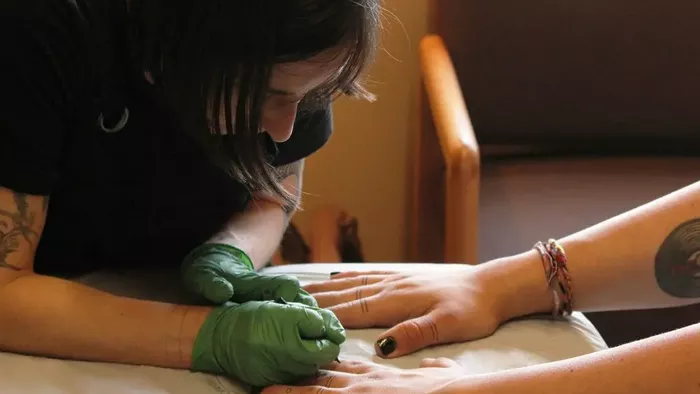In a modest room at the Kwanlin Dün First Nation’s health centre in Whitehorse, Anne Spice is deeply engrossed in her work. Using a single needle, a small cart of supplies, and a simple massage bed, she practices an Indigenous tattooing tradition that nearly vanished.
“These tattoos identify us as Indigenous people and connect us to others,” Spice told APTN News. “Few people remember or have seen these tattoos before colonization.”
Spice is a handpoked tattoo artist. This slow, delicate method involves dipping a needle into ink and manually poking it into the skin. She learned this technique six years ago during an Indigenous land occupation. Her designs are mostly linework, inspired by basketry and cultural imagery.
Originally from southern Alberta, Spice teaches Indigenous arthrology at Toronto Metropolitan University. For the past two summers, she has returned to her ancestral community to tattoo as part of the Shakaat artist in residence program in Whitehorse. This summer, she is tattooing for her First Nation, planning to ink over 24 Kwanlin Dün citizens. The First Nation’s health and wellness team funds her work as part of an initiative to incorporate traditional healing methods.
One of her clients, Olvia Gatensby, chose a circle and two lines representing the moon and a river on her fingers, symbolizing life changes and transitions. Gatensby, who is transitioning from male to female, said, “It connects me with a culture I haven’t been connected with. I’m excited to make that link.”
Spice sees her work as an honor. “It can be a vulnerable experience, both materially and emotionally,” she said. “It’s a healing ceremony, but also a painful one. It’s more than just a mark on the skin; it’s the process of getting to that mark.”
Revitalizing an Ancient Practice
Traditional Indigenous tattooing dates back thousands of years and was widespread before colonization. Tattoos marked life transitions, such as childbirth, becoming a warrior, or achieving chiefdom. Clan crests were common chest tattoos for Tlingit chiefs, and women often tattooed their hands and chins to signify clan membership and coming of age.
Tattoos were typically done with sharpened bone, and ink was made from charcoal, devil’s club leaves, and other medicinal plants. The process involved poking ink into the skin, rubbing it into cuts, or sewing it in with sinew. However, missionaries frowned upon and eventually outlawed tattooing and potlatches, leading to feelings of shame and fear around the practice.
“Colonization brought violence and discomfort to these markings,” Spice said. “There’s still some lingering fear, but the connection is a source of pride.”
The practice is experiencing a resurgence. Indigenous groups such as the Maori in New Zealand and native Hawaiians are embracing their tattoo traditions. Public figures like Quannah Chasinghorse, a Hän Gwich’in and Oglala model with traditional face tattoos, are helping bring these tattoos into the mainstream.
Spice believes in the importance of reviving tattooing as a healing practice. “Our work is to help people find pride, not fear, in these connections,” she said. “Seeing these marks on others honors our culture.”
She is optimistic about the future. “I love thinking about our Elders aging with these tattoos and young people seeing them. It’s a powerful connection to our heritage.”

